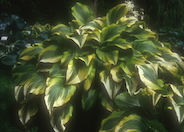
Common name:Hedge Lavender
Botanical name:Lavandula X intermedia
This attractive evergreen shrub reaches 2' tall and wide. Foliage is dense, gray green and aromatic. Leaves turn bronze and then purple during winter. Thin, erect, small tubular, purple flowers top the foliage during summer, attracting bees. This plant does well in full sun with neutral to alkaline, well-draining soil. Harvest flower stems when they are in bud stage to retain fragrance for potpourri or other crafts. This plant may be sheared for shape or tip-pruned in early summer to encourage density.

Common name:Bitsy Daylily
Botanical name:Hemerocallis 'Bitsy'
This dependable perennial has thin, strap-like, grass-like leaves reaching 12"-18" tall. Bright yellow flowers, resembling lilies, are high above the foliage, making the overall height of this plant at 24" tall. Blooms appear in spring through fall, thus making this Hemerocallis variety very popular. It needs regular watering and more during hot summer months. It prefers full sun or light shade and will tolerate seaside conditions.

Common name:Ever Red Japanese Maple
Botanical name:Acer palmatum 'Ever Red'
The Laceleaf Japanese Maple stands 10 feet high and 12 feet wide, with a pendulous growth habit and silver pubescens on new growth.

Common name:Hosta (hybrid) assorted
Botanical name:Hosta hybrids
Has various leaf shapes, textures and colors. They form striking clumps. Both flowers and foliage are nice in fresh arrangements. Part to full shade. Keep away from slugs.

Common name:Crimson Pygmy Japanese Barberry
Botanical name:Berberis thunbergii 'Crimson Pygmy'
Pygmy purple leaf barberry is a deciduous shrub with arching branches which reaches 2 ft high and 3 ft wide. The foliage becomes bronzy red in summer and fall. 'Crimson Pygmy' prefers full sun and regular watering, more in hot summer months. This plant has thorns. It makes a great hedge. Prune in winter to re-shape.
Designer: Debbie Snyder-Brooks
Photographer: Debbie Snyder-Brooks
Incorporate compost 6" into your soil to retain water, reduce compaction, feed earthworms, and provide valuable nutrients to your plants.
Remove irrigation water and fertilizer from areas where you don't want weeds to grow.